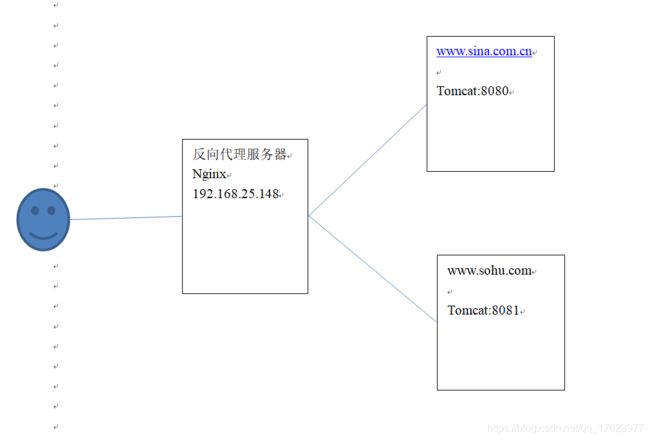黑马淘淘商城第十天 nginx的安装 、Nginx配置虚拟机、Nginx实现反向代理、Nginx实现负载均衡、Sso系统工程搭建
1. 课程计划
第十天:
1、nginx的安装
2、Nginx配置虚拟机
3、Nginx实现反向代理
4、Nginx实现负载均衡
5、Sso系统工程搭建
2. 什么是nginx
Nginx是一款高性能的http 服务器/反向代理服务器及电子邮件(IMAP/POP3)代理服务器。由俄罗斯的程序设计师Igor Sysoev所开发,官方测试nginx能够支支撑5万并发链接,并且cpu、内存等资源消耗却非常低,运行非常稳定。
3. 应用场景
1、http服务器。Nginx是一个http服务可以独立提供http服务。可以做网页静态服务器。
2、虚拟主机。可以实现在一台服务器虚拟出多个网站。例如个人网站使用的虚拟主机。
3、反向代理,负载均衡。当网站的访问量达到一定程度后,单台服务器不能满足用户的请求时,需要用多台服务器集群可以使用nginx做反向代理。并且多台服务器可以平均分担负载,不会因为某台服务器负载高宕机而某台服务器闲置的情况。
4. nginx安装
下载nginx:
官方网站:
http://nginx.org/
使用的版本是1.8.0版本。

Nginx提供的源码。
4.1. 要求的安装环境
1、需要安装gcc的环境。yum install gcc-c++
2、第三方的开发包。
PCRE
PCRE(Perl Compatible Regular Expressions)是一个Perl库,包括 perl 兼容的正则表达式库。nginx的http模块使用pcre来解析正则表达式,所以需要在linux上安装pcre库。
yum install -y pcre pcre-devel
注:pcre-devel是使用pcre开发的一个二次开发库。nginx也需要此库。
zlib
zlib库提供了很多种压缩和解压缩的方式,nginx使用zlib对http包的内容进行gzip,所以需要在linux上安装zlib库。
yum install -y zlib zlib-devel
openssl
OpenSSL 是一个强大的安全套接字层密码库,囊括主要的密码算法、常用的密钥和证书封装管理功能及SSL协议,并提供丰富的应用程序供测试或其它目的使用。
nginx不仅支持http协议,还支持https(即在ssl协议上传输http),所以需要在linux安装openssl库。
yum install -y openssl openssl-devel
4.2. 安装步骤
nginx
第一步:把nginx的源码包上传到linux系统
第二步:解压缩
[root@localhost ~]# tar zxf nginx-1.8.0.tar.gz
第三步:使用configure命令创建一makeFile文件。
./configure
–prefix=/usr/local/taotao-server/nginx
–pid-path=/var/run/nginx/nginx.pid
–lock-path=/var/lock/nginx.lock
–error-log-path=/var/log/nginx/error.log
–http-log-path=/var/log/nginx/access.log
–with-http_gzip_static_module
–http-client-body-temp-path=/var/temp/nginx/client
–http-proxy-temp-path=/var/temp/nginx/proxy
–http-fastcgi-temp-path=/var/temp/nginx/fastcgi
–http-uwsgi-temp-path=/var/temp/nginx/uwsgi
–http-scgi-temp-path=/var/temp/nginx/scgi
注意:启动nginx之前,上边将临时文件目录指定为/var/temp/nginx,需要在/var下创建temp及nginx目录
[root@localhost sbin]# mkdir /var/temp/nginx/client -p
第四步:make
第五步:make install

4.3. 启动nginx
进入sbin目录
[root@localhost sbin]# ./nginx

关闭nginx:
[root@localhost sbin]# ./nginx -s stop
推荐使用:
[root@localhost sbin]# ./nginx -s quit
重启nginx:
1、先关闭后启动。
2、动态刷新配置文件:
[root@localhost sbin]# ./nginx -s reload
4.4. 访问nginx
5. 配置虚拟主机
就是在一台服务器启动多个网站。
如何区分不同的网站:
1、域名不同
2、端口不同
5.1. 通过端口区分不同虚拟机
Nginx的配置文件:
/usr/local/nginx/conf/nginx.conf
#user nobody;
worker_processes 1;
#error_log logs/error.log;
#error_log logs/error.log notice;
#error_log logs/error.log info;
#pid logs/nginx.pid;
events {
worker_connections 1024;
}
http {
include mime.types;
default_type application/octet-stream;
#log_format main '$remote_addr - $remote_user [$time_local] "$request" '
# '$status $body_bytes_sent "$http_referer" '
# '"$http_user_agent" "$http_x_forwarded_for"';
#access_log logs/access.log main;
sendfile on;
#tcp_nopush on;
#keepalive_timeout 0;
keepalive_timeout 65;
#gzip on;
server {
listen 80;
server_name localhost;
#charset koi8-r;
#access_log logs/host.access.log main;
location / {
root html;
index index.html index.htm;
}
}
}
可以配置多个server,配置了多个虚拟主机。
添加虚拟主机:
#user nobody;
worker_processes 1;
#error_log logs/error.log;
#error_log logs/error.log notice;
#error_log logs/error.log info;
#pid logs/nginx.pid;
events {
worker_connections 1024;
}
http {
include mime.types;
default_type application/octet-stream;
#log_format main '$remote_addr - $remote_user [$time_local] "$request" '
# '$status $body_bytes_sent "$http_referer" '
# '"$http_user_agent" "$http_x_forwarded_for"';
#access_log logs/access.log main;
sendfile on;
#tcp_nopush on;
#keepalive_timeout 0;
keepalive_timeout 65;
#gzip on;
server {
listen 80;
server_name localhost;
#charset koi8-r;
#access_log logs/host.access.log main;
location / {
root html;
index index.html index.htm;
}
}
server {
listen 81;
server_name localhost;
#charset koi8-r;
#access_log logs/host.access.log main;
location / {
root html-81;
index index.html index.htm;
}
}
}
重新加载配置文件
[root@localhost nginx]# sbin/nginx -s reload
5.2. 通过域名区分虚拟主机
5.2.1. 什么是域名
域名就是网站。
www.baidu.com
www.taobao.com
www.jd.com
Tcp/ip
Dns服务器:把域名解析为ip地址。保存的就是域名和ip的映射关系。
一级域名:
Baidu.com
Taobao.com
Jd.com
二级域名:
www.baidu.com
Image.baidu.com
Item.baidu.com
三级域名:
1.Image.baidu.com
Aaa.image.baidu.com
一个域名对应一个ip地址,一个ip地址可以被多个域名绑定。
本地测试可以修改host文件。
修改window的hosts文件:(C:\Windows\System32\drivers\etc)
可以配置域名和ip的映射关系,如果hosts文件中配置了域名和ip的对应关系,不需要走dns服务器。

5.2.2. Nginx的配置
#user nobody;
worker_processes 1;
#error_log logs/error.log;
#error_log logs/error.log notice;
#error_log logs/error.log info;
#pid logs/nginx.pid;
events {
worker_connections 1024;
}
http {
include mime.types;
default_type application/octet-stream;
#log_format main '$remote_addr - $remote_user [$time_local] "$request" '
# '$status $body_bytes_sent "$http_referer" '
# '"$http_user_agent" "$http_x_forwarded_for"';
#access_log logs/access.log main;
sendfile on;
#tcp_nopush on;
#keepalive_timeout 0;
keepalive_timeout 65;
#gzip on;
server {
listen 80;
server_name localhost;
#charset koi8-r;
#access_log logs/host.access.log main;
location / {
root html;
index index.html index.htm;
}
}
server {
listen 81;
server_name localhost;
#charset koi8-r;
#access_log logs/host.access.log main;
location / {
root html-81;
index index.html index.htm;
}
}
server {
listen 80;
server_name www.taobao.com;
#charset koi8-r;
#access_log logs/host.access.log main;
location / {
root html-taobao;
index index.html index.htm;
}
}
server {
listen 80;
server_name www.baidu.com;
#charset koi8-r;
#access_log logs/host.access.log main;
location / {
root html-baidu;
index index.html index.htm;
}
}
}
域名的配置:
192.168.25.148 www.taobao.com
192.168.25.148 www.baidu.com
6. 反向代理
6.1. 什么是反向代理
6.2. Nginx实现反向代理
两个域名指向同一台nginx服务器,用户访问不同的域名显示不同的网页内容。
两个域名是www.sian.com.cn和www.sohu.com
nginx服务器使用虚拟机192.168.101.3

第一步:安装两个tomcat,分别运行在8080和8081端口。
第二步:启动两个tomcat。
第三步:反向代理服务器的配置
upstream tomcat1 {
server 192.168.25.148:8080;
}
server {
listen 80;
server_name www.sina.com.cn;
#charset koi8-r;
#access_log logs/host.access.log main;
location / {
proxy_pass http://tomcat1;
index index.html index.htm;
}
}
upstream tomcat2 {
server 192.168.25.148:8081;
}
server {
listen 80;
server_name www.sohu.com;
#charset koi8-r;
#access_log logs/host.access.log main;
location / {
proxy_pass http://tomcat2;
index index.html index.htm;
}
}
第四步:nginx重新加载配置文件
第五步:配置域名
在hosts文件中添加域名和ip的映射关系
192.168.25.148 www.sina.com.cn
192.168.25.148 www.sohu.com
7. 负载均衡
如果一个服务由多条服务器提供,需要把负载分配到不同的服务器处理,需要负载均衡。
upstream tomcat2 {
server 192.168.25.148:8081;
server 192.168.25.148:8082;
}
可以根据服务器的实际情况调整服务器权重。权重越高分配的请求越多,权重越低,请求越少。默认是都是1
upstream tomcat2 {
server 192.168.25.148:8081;
server 192.168.25.148:8082 weight=2;
}
8. Nginx的高可用(了解)
要实现nginx的高可用,需要实现备份机。
8.1. 什么是负载均衡高可用
nginx作为负载均衡器,所有请求都到了nginx,可见nginx处于非常重点的位置,如果nginx服务器宕机后端web服务将无法提供服务,影响严重。
为了屏蔽负载均衡服务器的宕机,需要建立一个备份机。主服务器和备份机上都运行高可用(High Availability)监控程序,通过传送诸如“I am alive”这样的信息来监控对方的运行状况。当备份机不能在一定的时间内收到这样的信息时,它就接管主服务器的服务IP并继续提供负载均衡服务;当备份管理器又从主管理器收到“I am alive”这样的信息时,它就释放服务IP地址,这样的主服务器就开始再次提供负载均衡服务。
8.2. keepalived+nginx实现主备
keepalived资料
8.2.1. 什么是keepalived
keepalived是集群管理中保证集群高可用的一个服务软件,用来防止单点故障。
Keepalived的作用是检测web服务器的状态,如果有一台web服务器死机,或工作出现故障,Keepalived将检测到,并将有故障的web服务器从系统中剔除,当web服务器工作正常后Keepalived自动将web服务器加入到服务器群中,这些工作全部自动完成,不需要人工干涉,需要人工做的只是修复故障的web服务器。
8.2.2. keepalived工作原理
keepalived是以VRRP协议为实现基础的,VRRP全称Virtual Router Redundancy Protocol,即虚拟路由冗余协议。
虚拟路由冗余协议,可以认为是实现路由器高可用的协议,即将N台提供相同功能的路由器组成一个路由器组,这个组里面有一个master和多个backup,master上面有一个对外提供服务的vip(VIP = Virtual IP Address,虚拟IP地址,该路由器所在局域网内其他机器的默认路由为该vip),master会发组播,当backup收不到VRRP包时就认为master宕掉了,这时就需要根据VRRP的优先级来选举一个backup当master。这样的话就可以保证路由器的高可用了。
keepalived主要有三个模块,分别是core、check和VRRP。core模块为keepalived的核心,负责主进程的启动、维护以及全局配置文件的加载和解析。check负责健康检查,包括常见的各种检查方式。VRRP模块是来实现VRRP协议的。
详细参考:Keepalived权威指南中文.pdf
8.2.3. keepalived+nginx实现主备过程
初始状态
 主机宕机
主机宕机

主机恢复

8.2.4. 高可用环境
两台nginx,一主一备:192.168.101.3和192.168.101.4
两台tomcat服务器:192.168.101.5、192.168.101.6
8.2.5. 安装keepalived
分别在主备nginx上安装keepalived,参考“安装手册”进行安装:
9. Sso系统分析
9.1. 什么是sso系统
SSO英文全称Single Sign On,单点登录。SSO是在多个应用系统中,用户只需要登录一次就可以访问所有相互信任的应用系统。它包括可以将这次主要的登录映射到其他应用中用于同一个用户的登录的机制。它是目前比较流行的企业业务整合的解决方案之一。
9.2. 为什么要有单点登录系统
9.2.1. 传统的登录实现方式

此方式在只有一个web工程时是没有问题。
9.2.2. 集群环境下

集群环境下会出现要求用户多次登录的情况。
解决方案:
1、配置tomcat集群。配置tomcatSession复制。节点数不要超过5个。
2、可以使用Session服务器,保存Session信息,使每个节点是无状态。需要模拟Session。
单点登录系统是使用redis模拟Session,实现Session的统一管理。
10. Sso系统的实现

需要创建一个sso服务工程,可以参考taotao-manager创建。
1.1. 工程搭建
Taotao-sso(pom聚合工程)
|–taotao-sso-interface(jar)
|–taotao-sso-Service(war)
可以参考taotao-manager创建
<project xmlns="http://maven.apache.org/POM/4.0.0" xmlns:xsi="http://www.w3.org/2001/XMLSchema-instance"
xsi:schemaLocation="http://maven.apache.org/POM/4.0.0 http://maven.apache.org/xsd/maven-4.0.0.xsd">
<modelVersion>4.0.0</modelVersion>
<parent>
<groupId>com.taotao</groupId>
<artifactId>taotao-parent</artifactId>
<version>0.0.1-SNAPSHOT</version>
</parent>
<groupId>com.taotao</groupId>
<artifactId>taotao-sso</artifactId>
<version>0.0.1-SNAPSHOT</version>
<packaging>pom</packaging>
<dependencies>
<dependency>
<groupId>com.taotao</groupId>
<artifactId>taotao-common</artifactId>
<version>0.0.1-SNAPSHOT</version>
</dependency>
</dependencies>
<!-- 配置tomcat插件 -->
<build>
<plugins>
<plugin>
<groupId>org.apache.tomcat.maven</groupId>
<artifactId>tomcat7-maven-plugin</artifactId>
<configuration>
<port>8087</port>
<path>/</path>
</configuration>
</plugin>
</plugins>
</build>
</project>
10.1.2. taotao-sso-interface


10.1.3. taotao-sso-service

Pom文件
<project xmlns="http://maven.apache.org/POM/4.0.0" xmlns:xsi="http://www.w3.org/2001/XMLSchema-instance"
xsi:schemaLocation="http://maven.apache.org/POM/4.0.0 http://maven.apache.org/xsd/maven-4.0.0.xsd">
<modelVersion>4.0.0</modelVersion>
<parent>
<groupId>com.taotao</groupId>
<artifactId>taotao-sso</artifactId>
<version>0.0.1-SNAPSHOT</version>
</parent>
<artifactId>taotao-sso-service</artifactId>
<packaging>war</packaging>
<dependencies>
<dependency>
<groupId>com.taotao</groupId>
<artifactId>taotao-manager-dao</artifactId>
<version>0.0.1-SNAPSHOT</version>
</dependency>
<dependency>
<groupId>com.taotao</groupId>
<artifactId>taotao-sso-interface</artifactId>
<version>0.0.1-SNAPSHOT</version>
</dependency>
<!-- spring的依赖 -->
<!-- Spring -->
<dependency>
<groupId>org.springframework</groupId>
<artifactId>spring-context</artifactId>
</dependency>
<dependency>
<groupId>org.springframework</groupId>
<artifactId>spring-beans</artifactId>
</dependency>
<dependency>
<groupId>org.springframework</groupId>
<artifactId>spring-webmvc</artifactId>
</dependency>
<dependency>
<groupId>org.springframework</groupId>
<artifactId>spring-jdbc</artifactId>
</dependency>
<dependency>
<groupId>org.springframework</groupId>
<artifactId>spring-aspects</artifactId>
</dependency>
<dependency>
<groupId>org.springframework</groupId>
<artifactId>spring-jms</artifactId>
</dependency>
<dependency>
<groupId>org.springframework</groupId>
<artifactId>spring-context-support</artifactId>
</dependency>
<!-- dubbo相关 -->
<dependency>
<groupId>com.alibaba</groupId>
<artifactId>dubbo</artifactId>
<!-- 排除依赖 -->
<exclusions>
<exclusion>
<groupId>org.springframework</groupId>
<artifactId>spring</artifactId>
</exclusion>
<exclusion>
<groupId>org.jboss.netty</groupId>
<artifactId>netty</artifactId>
</exclusion>
</exclusions>
</dependency>
<dependency>
<groupId>org.apache.zookeeper</groupId>
<artifactId>zookeeper</artifactId>
</dependency>
<dependency>
<groupId>com.github.sgroschupf</groupId>
<artifactId>zkclient</artifactId>
</dependency>
<!-- Redis客户端 -->
<dependency>
<groupId>redis.clients</groupId>
<artifactId>jedis</artifactId>
</dependency>
</dependencies>
</project>
10.2. 表现层工程
表现层工程包含登录和注册页面,需要调用sso服务实现。
给app提供服务,restful形式的服务。
Taotao-sso-web(war包)
可以参考taotao-manager-web创建。
<project xmlns="http://maven.apache.org/POM/4.0.0" xmlns:xsi="http://www.w3.org/2001/XMLSchema-instance"
xsi:schemaLocation="http://maven.apache.org/POM/4.0.0 http://maven.apache.org/xsd/maven-4.0.0.xsd">
<modelVersion>4.0.0</modelVersion>
<parent>
<groupId>com.taotao</groupId>
<artifactId>taotao-parent</artifactId>
<version>0.0.1-SNAPSHOT</version>
</parent>
<groupId>com.taotao</groupId>
<artifactId>taotao-sso-web</artifactId>
<version>0.0.1-SNAPSHOT</version>
<packaging>war</packaging>
<dependencies>
<dependency>
<groupId>com.taotao</groupId>
<artifactId>taotao-sso-interface</artifactId>
<version>0.0.1-SNAPSHOT</version>
</dependency>
<!-- Spring -->
<dependency>
<groupId>org.springframework</groupId>
<artifactId>spring-context</artifactId>
</dependency>
<dependency>
<groupId>org.springframework</groupId>
<artifactId>spring-beans</artifactId>
</dependency>
<dependency>
<groupId>org.springframework</groupId>
<artifactId>spring-webmvc</artifactId>
</dependency>
<dependency>
<groupId>org.springframework</groupId>
<artifactId>spring-jdbc</artifactId>
</dependency>
<dependency>
<groupId>org.springframework</groupId>
<artifactId>spring-aspects</artifactId>
</dependency>
<dependency>
<groupId>org.springframework</groupId>
<artifactId>spring-jms</artifactId>
</dependency>
<dependency>
<groupId>org.springframework</groupId>
<artifactId>spring-context-support</artifactId>
</dependency>
<!-- JSP相关 -->
<dependency>
<groupId>jstl</groupId>
<artifactId>jstl</artifactId>
</dependency>
<dependency>
<groupId>javax.servlet</groupId>
<artifactId>servlet-api</artifactId>
<scope>provided</scope>
</dependency>
<dependency>
<groupId>javax.servlet</groupId>
<artifactId>jsp-api</artifactId>
<scope>provided</scope>
</dependency>
<!-- dubbo相关 -->
<dependency>
<groupId>com.alibaba</groupId>
<artifactId>dubbo</artifactId>
<!-- 排除依赖 -->
<exclusions>
<exclusion>
<groupId>org.springframework</groupId>
<artifactId>spring</artifactId>
</exclusion>
<exclusion>
<groupId>org.jboss.netty</groupId>
<artifactId>netty</artifactId>
</exclusion>
</exclusions>
</dependency>
<dependency>
<groupId>org.apache.zookeeper</groupId>
<artifactId>zookeeper</artifactId>
</dependency>
<dependency>
<groupId>com.github.sgroschupf</groupId>
<artifactId>zkclient</artifactId>
</dependency>
<dependency>
<groupId>junit</groupId>
<artifactId>junit</artifactId>
</dependency>
</dependencies>
<!-- 配置tomcat插件 -->
<build>
<plugins>
<plugin>
<groupId>org.apache.tomcat.maven</groupId>
<artifactId>tomcat7-maven-plugin</artifactId>
<configuration>
<port>8088</port>
<path>/</path>
</configuration>
</plugin>
</plugins>
</build>
</project>






